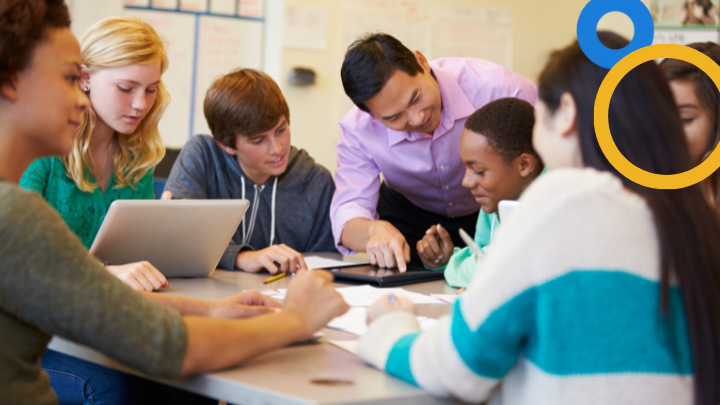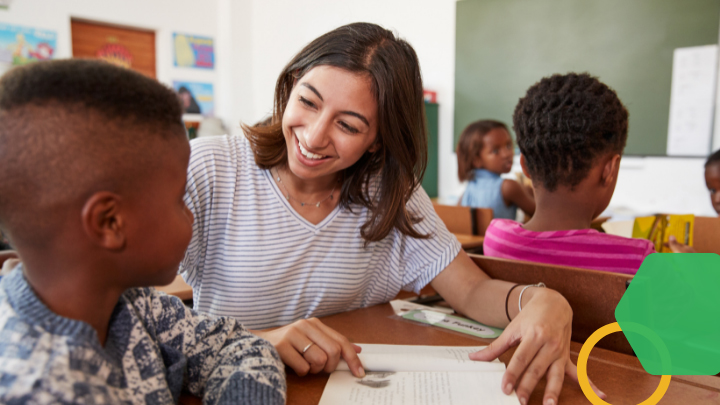Education has shifted; although many schools are back to teaching in person, educators know that components of hybrid and virtual learning are here to stay. We know that in order to keep learning engaging, meaningful, and student-centered, we have to be flexible. But with flexible learning comes the challenge of keeping students accountable for their learning.
By utilizing effective online resources, co-creating norms, developing clear and consistent structures and deadlines, and keeping student needs in mind, educators can build a learning environment that reaches all learners and paves the way for student ownership. Here are some helpful strategies for accountability as well as coach tips to help you achieve the virtual, hybrid, or in-person learning environment you are envisioning.
Create clear norms and expectations with your students.
By creating clear norms and expectations with your students instead of just for them, you can hold students accountable for their behavior inside and outside of a lesson and use student voice to create community and increase engagement. This also ensures you are all on the same page and have agreed to these rules/norms.
- Have a discussion with your students that allows for creating shared work time norms and expectations together.
- Similarly, creating and improving class rules and procedures with students gives students a voice in developing rules as well as revising them as needed.
- Signing and agreeing to student contracts in group work and solo work can be another way to set clear expectations and consequences.
Coach tip
Don’t wait to do this! Do this in your lesson or before introducing a new online resource. Revisit these norms and expectations often with your students depending on their needs. Allow them to self-assess and give them a voice to adjust these norms as a class community if they feel necessary throughout the school year.
Prioritize relationships by using consistent structures for checking in/monitoring progress.
By creating time to check in as a class, set goals, and conference around those goals, you can strengthen and maintain those relationships and keep students on track. A class meeting is also a great time to allow students to brainstorm and share around what routines might need readjusting to better serve your entire class community.
- Provide consistency by thresholding to greet students at the door. This helps keep each student accountable for coming to class and feeling valued in a virtual, hybrid, or in-person setting.
- Use a class meeting or morning meeting time to celebrate success, set goals, discuss and tweak any class rules, or share updates. As an educator, there is a lot of material to cover, but those few minutes that you spend in this meeting time will be worth it.
- Try conferencing with students: Student conferences with the teacher and data review and goal setting conference can help your students reflect on their progress, receive teacher feedback, and—if necessary—brainstorm solutions for accountability.
Coach tip
I always started my lessons by greeting each student so they knew I saw them and valued them. This automatically holds them accountable for being in class. Then, I moved into our class meeting time. By creating a routine around greeting students and meeting with students as a class and then individually, students know what to expect and that their presence, voice, and work matters. Additionally, by conferencing individually with students, I was able to get to know them on a deeper level and by strengthening that relationship, they stayed more accountable.
Be clear with goals and deadlines.
Another barrier to keeping students accountable is helping them stay on top of assignments and deadlines. It’s important to use a calendar system so students know what they need to accomplish and where they are headed, especially in self-paced work. Show this calendar to the entire class and provide access and a copy for students. Depending on your grade level, you can give more support in this process if necessary.
- Using a pacing calendar to support students’ self-paced work will help them take ownership of their process and stay on track.
Coach tip
Don’t forget that many students have several teachers and subjects to balance. We all need deadlines to keep us on track. Planning towards deadlines is an important life skill; it also helps you as the teacher when you are planning and thinking about what your students need.
Keep students engaged throughout the learning process.
We all know that sometimes students “tune out” whether they’re in person or across a screen. Provide stopping points or checkpoints for students to interact with each other, complete a quick exit ticket, or give peer feedback on assignments. If you are holding class in an online or hybrid environment, giving students online “jobs” can also make them feel more involved within the lesson.
- By creating exit tickets, you can keep track of student progress and keep students accountable for the learning in each portion of the lesson. Many online platforms such as Google Forms can help you create a simple and quick exit ticket if you are working online.
- A chalk talk or silent discussion is a great way to involve all students in the thinking at any part of a lesson or unit. In-person students can use sticky notes or colored markers. Online students can use platforms like Padlet or Google Jamboard.
- Utilize peer feedback tools: Giving and receiving peer feedback helps students stay accountable for not just improving their own work, but also the work of others.
Coach tip
For online classrooms, reflect on the structures you used within the walls of a physical classroom and think about how you could bring those to life online. For example, many jobs in the in-person classroom can be transitioned into online learning, such as the “time keeper,” and there is room for many roles that are unique to online learning, like the “chat monitor.” Try classroom jobs to give students ownership and make them feel valued throughout the learning process. In my classroom, our favorite feedback tool in-person was “glow and grow” so while online we continued to give this feedback within different sharing options like Google Docs.
Create personalized pathways.
Creating personalized pathways can have the biggest impact on student accountability because it allows your students to take ownership of their learning, understand where they are, track progress, and work towards goals.
- Use self-assessment tools to help students determine growth areas: Marzano’s self-assessment rubric is a great way for students to gauge how much support they need and help them to determine the appropriate next steps or activity to choose.
- Use goal setting/reflection templates to help students determine their strengths and areas in need of growth and encourage ownership and accountability for working towards those goals.
- Try implementing an individual progress and mastery tracking system. This is the ultimate accountability strategy; competency-based learning gives students ownership over their learning and data. There are various approaches to this strategy and it can be personalized to you and your students.
Coach tip
Creating a competency-based learning system can feel overwhelming at first. Start small by implementing goal setting and self-assessment tools to help students be more reflective about where they are within a standard/concept. You can learn more about competency-based learning here.
Provide options for extra support.
In class, it may seem like your students “got it,” but when they go to complete the assignment asynchronously or independently without you there, they may need help. Providing opportunities for extra support while you’re not there will help your students stay accountable with trying out their work even when it feels difficult.
Coach tip
For online learning, one way to provide extra support is by using video for flipped learning environments. These videos can help students with specific skills and allow for quick checks for understanding. You can also use programs like Zoom, Loom, and Screencastify to record short videos of yourself to help your students better understand a concept, find where to access materials, or outline the goals of an assignment. This is also extremely helpful for families who are trying to support their children at home.
Motivate students by celebrating growth and success.
In order to stay accountable, students need to feel that their work is important and means something. A simple digital space to share and celebrate growth and success can make a huge difference.
- A positive news board is a great place for students to recognize the growth that has emerged from their hard work. This board can be up in an in-person classroom or created in a digital space.
Coach tip
You can have students add to the board themselves by using Padlet or Google Jamboard in a virtual or hybrid environment. In-person students can easily add to a physical board with sticky notes or notecards. Encouraging students to celebrate themselves as well as their peers fosters key social-emotional skills such as relationship skills. You can take a brief period of time daily or each week (ex: five to ten minutes) to verbally share out bright spots or “glows” from the week.
By holding our students accountable, we hold ourselves as educators accountable. We ensure that our expectations and directions are clear, that we are strengthening our relationships with all students, that we know where we’re headed, and that we can create systems to engage and support all students in their own learning journey—whether that’s in a virtual, hybrid, or in-person classroom. Our students are very capable, but we have to help them get there. At the heart of this work is continuous improvement: trying, measuring, and learning (TML).
If you would like further support implementing these strategies, a BetterLesson instructional coach can help you get started. If you are interested in learning more about hybrid and virtual learning, explore this focus area here.








